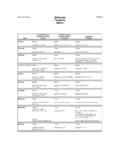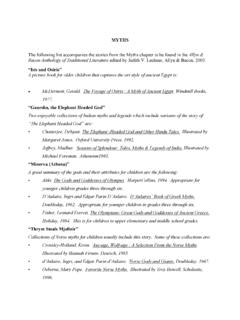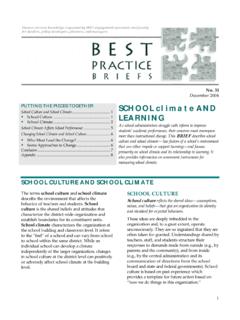Transcription of Chapter 2 Creating a Safe and Inclusive Learning Environment
1 Chapter 2 1 Chapter 2 Creating a safe and Inclusive Learning Environment Probing questions 1. What might we mean by the phrase physical Education is for everyBODY ? 2. Do you think girls get a fair go in physical education? 3. Do you think a Westernized bias exists in physical education that supports activities that may be difficult for some children to fully participate in due to religious convictions? 4. What are some of the potential safety barriers that teachers face during physical education? The joys of engaging in physical activity should not be limited to those with exceptional hand-eye coordination and excellent physical fitness. Nor should those children who belong to the dominant ethnic group or just boys only experience enjoyment. Discrimination in all forms of education is prohibited under federal law yet it is still present in many forms within physical education. Part of the predicament can be attributed to the attitudes of the students themselves, many of who insist on acting out physical , gender, racial and religious stereotypes.
2 However, even the most well intentioned teachers of physical education can be reinforcing this type of discrimination by their use of certain teaching behaviors and delivery of the curriculum. The purpose of this Chapter is to examine issues relating to the presentation of a safe and Inclusive physical education. While in customary educational terminology, inclusion refers specifically to children with special needs, in this Chapter we expand the concept to include children who face barriers due to gender, body composition, language differences, cultural experiences, and cognitive, physical or psychological disabilities. As a result, we aim to provide you with some strategies so that you can Chapter 2 2 provide a physical education for EVERY - BODY fat ones, colored ones, brittle ones, and ones about whom we know little due to their culture. The notion of inclusion Inclusion is not merely a placement or setting. Inclusion is a state of being that enables all students to successfully participate, develop skills, and have a sense of belonging in a class.
3 An Inclusive school is a place where everyone belongs, is accepted, supports, and is supported by his/her peers and other members of the school community. This definition should also be the model for Inclusive physical education. To be included in physical education means being able to engage in the activities without being isolated from the group setting. The term isolation here is critical. Many children feel they do not belong in physical education due to their experiences in the subject. Some are ridiculed because of their lack of skill; others are excluded because of their perceived physical limitations. The precursor to this isolation is not always deliberate intent by teachers and students, but unfortunately in some cases it is. Scenarios of isolation The following scenarios describe five students who could easily be in one of your future classes. Consider how each of these children might perceive the importance of physical activity and physical education into their life projects.
4 Determine also, those critical features that might lead to feelings of segregation or isolation. Naweeda and Hadiq Naweeda s family is from Bangladesh, and lives in a neighborhood in which there are a number of other Muslin families. Naweeda s school requires that students change clothes for their physical education lessons into shorts and a t-shirt. She mostly wears a shalwar under her shorts, but on occasions, not wanting to receive more giggling from her classmates, chooses to wear only the shorts. A family friend who lives near the school has informed Naweeda s parents that she has seen her in public wearing shorts. This causes further tension within Naweeda s household since her brother Hadiq has been skipping swimming lessons. It is Ramadan, and during this time he has struggled to swim by keeping his head totally out of the water. Getting water in one s mouth during daytime hours is against the fast. Henry Henry is a large and significantly overweight boy who has particular difficulty in any activity that requires speed or agility.
5 In addition, Henry is quite low skilled, something compounded by his lack of mobility, but exacerbated by a significant lack of confidence. No one ever wants Henry on their team, and he always the one left without a partner when students are asked to pair up. During the most recent series of lessons on softball, some boys in Henry s class were overheard by their teacher making quite audible and deliberate references to Henry as the slug. Chapter 2 3 Foyzur Foyzur and his family have fled his native Ivory Coast due to the continued political unrest. While he is quite good at soccer, Foyzur has no experience whatsoever with this new form of football his class is Learning . Further, being able to speak only French, and having no Francophone classmates, Foyzur is struggling to learn many of the skills of the sport. Mandy Mandy is a chronic asthmatic who must carry her inhaler with her at all times. She enjoys some activities, but struggles with those in which there is significant exertion.
6 The current series of lessons sees her class practicing relay races, and her teacher has designed a series of stations that all involve vigorous running. Alex Alex has been in her wheelchair since a swimming pool accident in early childhood left her paralyzed below the waist. Alex enjoys being active, and plays often with her brother and sister at home. During physical education at school however, Alex is mostly asked if she would like to be the scorekeeper or umpire. Sometimes she is given a chance to bat during individual practice sessions, but she is never included on a team during a game. The 4 S s It is clear that there are significant obstructions in place that prevent the students described in the scenarios above from achieving fully in physical education. However, we ask whether what we might call problems ( , religious restrictions, lack of mobility) were actually those of the children, but of others within the physical education setting?
7 Might it well be that we have to examine our own notions of a positive physical education experience and make organized efforts to understand students needs and respond to them accordingly. Reeves and Stein (1999) provide us with a positive way of conceptualizing a physical education setting in which students should feel comfortable and confident in their participation. These 4 S s are safe , success, satisfying, and skill appropriate. By safe , the authors refer to the conduct of activity in which the student is protected from danger. A significant portion of this Chapter deals with all issues of physical safety. We would also like to add the notion of psychological or emotional safety as part of this first S. Students should feel they will be free from embarrassment or ridicule in their pursuit of physical activity. By success, we mean that students are able to attain a level of proficiency at a level that is appropriate for them.
8 For some, this might mean being able to dribble concurrently with two basketballs; for others, it might mean being able to control a ball in a stationary position with repeated bouncing and catching. Chapter 2 4 By satisfying, we mean that children find their participation in physical activity challenging and motivating. They need to have feelings of a sense of accomplishment. Good teachers adapt the curriculum, task, and/or Environment so that all students can experience this satisfaction. By skill appropriate, we mean that the instructional context is designed after a variety of individual characteristics such as developmental status, fitness and skill levels, body size, and age have been considered. Applying the 4 S s to children Reeves and Stein (1999) write of Dustin, Sarah, Nelda, and Lance, who all are 8-year-old children in one Inclusive classroom. Dustin, a child with mental retardation, has difficulty skipping with peers during a game of tag.
9 Sarah spends more time chasing the 8-inch playground ball than bouncing it. Nelda, a child with cerebral palsy, does a log roll on a diagonal. Lance has the rhythm with his feet, but has difficulty bringing the short jump rope over his head Reeves and Stein present two sets of possible responses that you could make as a teacher. Response 1. You shout to Dustin, You need to skip like everyone else! You inform Sarah, Watch the ball! You tell Nelda, Log roll in a straight path! You inform Lance, to try harder! .. Response 2. Since Dustin gallops very well, you go over to Dustin and quietly challenge him, Show me how you gallop. Now Dustin successfully gallops while his peers skip. You quietly hand Sarah a 14-inch playground ball to bounce with both hands. Now Sarah beams with delight as she bounces the ball to the rhythm of music. You encourage Nelda to log roll with her belly button on the mountain climbing rope that is laid in a vertical line down the center of the mat.
10 Now Nelda log rolls right down the center of the mat. Since Lance has difficulty turning the rope, you instruct him to jump rope with the long jump rope. The implications for presenting these children with a positive experience in physical education should be quite clear as one compares these two response options. The first half of Chapter 2 will examine strategies we can adopt so that students of the like of those in our initial scenarios can successfully participate and be accepted in a supportive and caring (emotionally safe ) physical education. The second half will provide details of how to achieve this in a safe physical Environment . Chapter 2 5 Including ethnically diverse populations understanding the importance of religion and cultural values American schools include a complex mixture of cultures, races, languages, and religions. More than 15% of school-age students speak a language other than English in their home Environment , and over 3 million children are classified as limited English proficient.



















